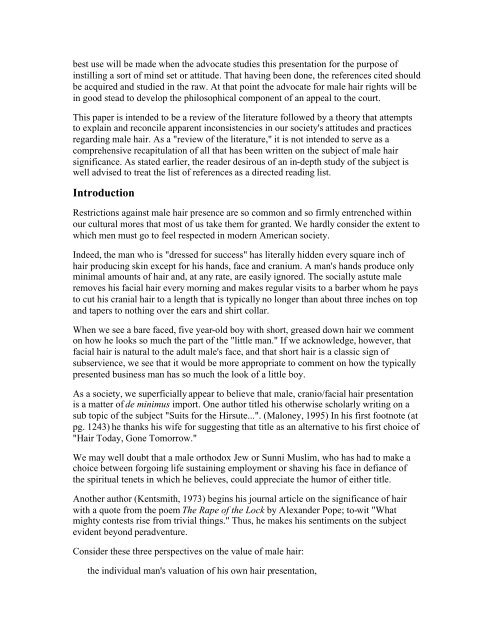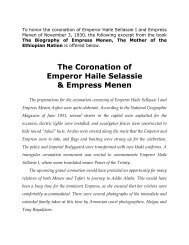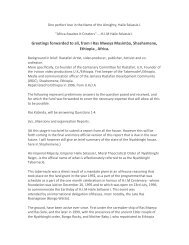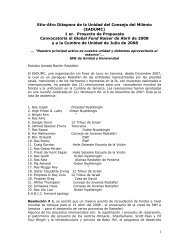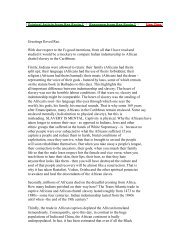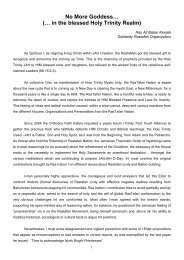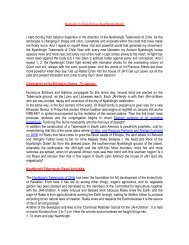DRAFT Universal Hair Exemption Letter TO: United ... - RasTa Ites
DRAFT Universal Hair Exemption Letter TO: United ... - RasTa Ites
DRAFT Universal Hair Exemption Letter TO: United ... - RasTa Ites
Create successful ePaper yourself
Turn your PDF publications into a flip-book with our unique Google optimized e-Paper software.
est use will be made when the advocate studies this presentation for the purpose of<br />
instilling a sort of mind set or attitude. That having been done, the references cited should<br />
be acquired and studied in the raw. At that point the advocate for male hair rights will be<br />
in good stead to develop the philosophical component of an appeal to the court.<br />
This paper is intended to be a review of the literature followed by a theory that attempts<br />
to explain and reconcile apparent inconsistencies in our society's attitudes and practices<br />
regarding male hair. As a "review of the literature," it is not intended to serve as a<br />
comprehensive recapitulation of all that has been written on the subject of male hair<br />
significance. As stated earlier, the reader desirous of an in-depth study of the subject is<br />
well advised to treat the list of references as a directed reading list.<br />
Introduction<br />
Restrictions against male hair presence are so common and so firmly entrenched within<br />
our cultural mores that most of us take them for granted. We hardly consider the extent to<br />
which men must go to feel respected in modern American society.<br />
Indeed, the man who is "dressed for success" has literally hidden every square inch of<br />
hair producing skin except for his hands, face and cranium. A man's hands produce only<br />
minimal amounts of hair and, at any rate, are easily ignored. The socially astute male<br />
removes his facial hair every morning and makes regular visits to a barber whom he pays<br />
to cut his cranial hair to a length that is typically no longer than about three inches on top<br />
and tapers to nothing over the ears and shirt collar.<br />
When we see a bare faced, five year-old boy with short, greased down hair we comment<br />
on how he looks so much the part of the "little man." If we acknowledge, however, that<br />
facial hair is natural to the adult male's face, and that short hair is a classic sign of<br />
subservience, we see that it would be more appropriate to comment on how the typically<br />
presented business man has so much the look of a little boy.<br />
As a society, we superficially appear to believe that male, cranio/facial hair presentation<br />
is a matter of de minimus import. One author titled his otherwise scholarly writing on a<br />
sub topic of the subject "Suits for the Hirsute...". (Maloney, 1995) In his first footnote (at<br />
pg. 1243) he thanks his wife for suggesting that title as an alternative to his first choice of<br />
"<strong>Hair</strong> Today, Gone Tomorrow."<br />
We may well doubt that a male orthodox Jew or Sunni Muslim, who has had to make a<br />
choice between forgoing life sustaining employment or shaving his face in defiance of<br />
the spiritual tenets in which he believes, could appreciate the humor of either title.<br />
Another author (Kentsmith, 1973) begins his journal article on the significance of hair<br />
with a quote from the poem The Rape of the Lock by Alexander Pope; to-wit "What<br />
mighty contests rise from trivial things." Thus, he makes his sentiments on the subject<br />
evident beyond peradventure.<br />
Consider these three perspectives on the value of male hair:<br />
the individual man's valuation of his own hair presentation,


